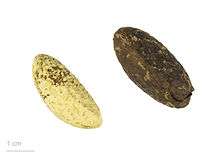Garcinia kola
| Garcinia kola | |
|---|---|
 | |
| Scientific classification | |
| Kingdom: | Plantae |
| (unranked): | Angiosperms |
| (unranked): | Eudicots |
| (unranked): | Rosids |
| Order: | Malpighiales |
| Family: | Clusiaceae |
| Genus: | Garcinia |
| Species: | G. kola |
| Binomial name | |
| Garcinia kola Heckel | |

Garcinia kola (bitter kola, a name sometimes also used for G. afzelii) is a species of flowering plant in the Clusiaceae or Guttiferae family. It is found in Benin, Cameroon, Democratic Republic of the Congo, Ivory Coast, Gabon, Ghana, Liberia, Nigeria, Senegal and Sierra Leone. Its natural habitat is subtropical or tropical moist lowland forests.
The fruit, seeds, nuts and bark of the plant have been used for centuries in folk medicine to treat ailments from coughs to fever. According to a report from the Center For International Forestry Research, Garcinia kola trade is still important to the tribes and villages in Nigeria.
Traditional medicine
Garcinia kola is traditionally used by African medicine men who believe that it has purgative, antiparasitic, and antimicrobial properties.[2] The seeds are used for bronchitis, throat infections, colic, head or chest colds, and cough.[2] It is also used for liver disorders and as a chewing stick.[2]
Barriers to cultivation
Despite its socio-economic importance of Garcinia kola, the cultivation of the species is very much limited. Factors that have discouraged farmers from growing Garcinia kola include difficulties encountered in the germination which reduces the availability of seedlings in the nurseries for possible plantation establishment. Most of the productive trees are those which were left in the wild when farm plots were cut out of the forest (Adebisi, 2004). Researchers have studied the germination problems of G. kola seeds and suggested various means of breaking its dormancy (Gyimah, 2000, Anegbeh et al., 2006, Kanmegne and Ndoumou, 2007, Oboho and Urughu, 2010, Oboho and Ogana, 2011). But there is still a great need to investigate more simple and practicable methods that could be easily adopted by the farmers with low technological input. G. kola seeds has both seeds coat dormancy and physiological dormancy probably imposed by the chemicals in the seed (Oboho and Urughu 2010). Seed coat dormancy of Garcinia kola can be reduced by removing the seed coat before sowing while the physiological dormancy can be reduced by soaking in water for 72 hours (Yakubu et al., 2014). the removal of the seed coat, soaking in water for 72 hours, placing inside air tight transparent polythene bag and sprinkling of water on the seeds when needed for constant moisture will give early germination period of 2 weeks (Yakubu et al., 2014).
References
- ↑ Cheek. M. 2004. Garcinia kola. 2006 IUCN Red List of Threatened Species. Downloaded on 20 July 2007.
- 1 2 3 Maurice Iwu, Angela R. Duncan, and Chris O. Okunji, New Antimicrobials of Plant Origin p. 457–462. 1999, ASHS Press, Alexandria, VA
